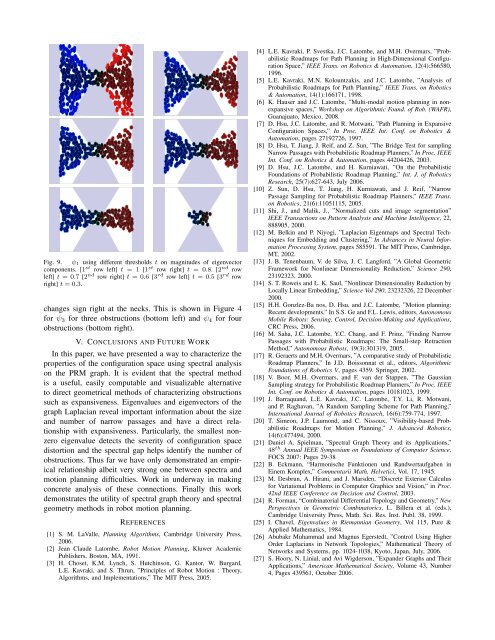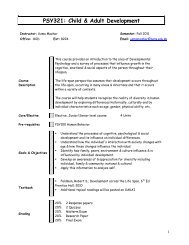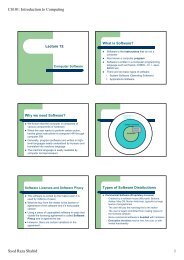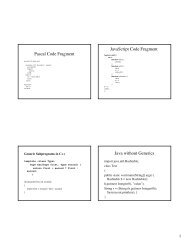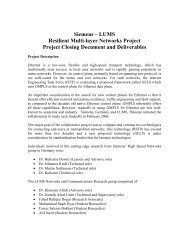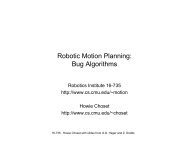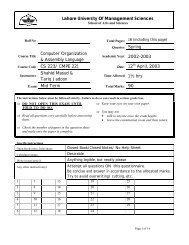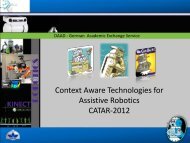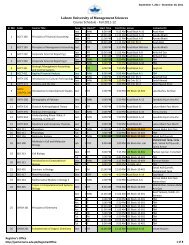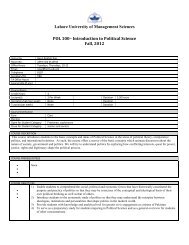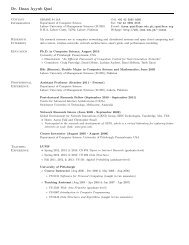Preprint - cyphynets
Preprint - cyphynets
Preprint - cyphynets
You also want an ePaper? Increase the reach of your titles
YUMPU automatically turns print PDFs into web optimized ePapers that Google loves.
Fig. 9. ψ 1 using different thresholds t on magnitudes of eigenvectorcomponents. [1 st row left] t = 1 [1 st row right] t = 0.8. [2 nd rowleft] t = 0.7 [2 nd row right] t = 0.6 [3 rd row left] t = 0.5 [3 rd rowright] t = 0.3.changes sign right at the necks. This is shown in Figure 4for ψ 3 for three obstructions (bottom left) and ψ 4 for fourobstructions (bottom right).V. CONCLUSIONS AND FUTURE WORKIn this paper, we have presented a way to characterize theproperties of the configuration space using spectral analysison the PRM graph. It is evident that the spectral methodis a useful, easily computable and visualizable alternativeto direct geometrical methods of characterizing obstructionssuch as expansiveness. Eigenvalues and eigenvectors of thegraph Laplacian reveal important information about the sizeand number of narrow passages and have a direct relationshipwith expansiveness. Particularly, the smallest nonzeroeigenvalue detects the severity of configuration spacedistortion and the spectral gap helps identify the number ofobstructions. Thus far we have only demonstrated an empiricalrelationship albeit very strong one between spectra andmotion planning difficulties. Work in underway in makingconcrete analysis of these connections. Finally this workdemonstrates the utility of spectral graph theory and spectralgeometry methods in robot motion planning.REFERENCES[1] S. M. LaValle, Planning Algorithms, Cambridge University Press,2006.[2] Jean Claude Latombe, Robot Motion Planning, Kluwer AcademicPublishers, Boston, MA, 1991.[3] H. Choset, K.M. Lynch, S. Hutchinson, G. Kantor, W. Burgard,L.E. Kavraki, and S. Thrun, ”Principles of Robot Motion : Theory,Algorithms, and Implementations,” The MIT Press, 2005.[4] L.E. Kavraki, P. Svestka, J.C. Latombe, and M.H. Overmars, ”ProbabilisticRoadmaps for Path Planning in High-Dimensional ConfigurationSpace,” IEEE Trans. on Robotics & Automation, 12(4):566580,1996.[5] L.E. Kavraki, M.N. Kolountzakis, and J.C. Latombe, ”Analysis ofProbabilistic Roadmaps for Path Planning,” IEEE Trans. on Robotics& Automation, 14(1):166171, 1998.[6] K. Hauser and J.C. Latombe, ”Multi-modal motion planning in nonexpansivespaces,” Workshop on Algorithmic Found. of Rob. (WAFR),Guanajuato, Mexico, 2008.[7] D. Hsu, J.C. Latombe, and R. Motwani, ”Path Planning in ExpansiveConfiguration Spaces,” In Proc. IEEE Int. Conf. on Robotics &Automation, pages 27192726, 1997.[8] D. Hsu, T. Jiang, J. Reif, and Z. Sun, ”The Bridge Test for samplingNarrow Passages with Probabilistic Roadmap Planners,” In Proc. IEEEInt. Conf. on Robotics & Automation, pages 44204426, 2003.[9] D. Hsu, J.C. Latombe, and H. Kurniawati, ”On the ProbabilisticFoundations of Probabilistic Roadmap Planning,” Int. J. of RoboticsResearch, 25(7):627-643, July 2006.[10] Z. Sun, D. Hsu, T. Jiang, H. Kurniawati, and J. Reif, ”NarrowPassage Sampling for Probabilistic Roadmap Planners,” IEEE Trans.on Robotics, 21(6):11051115, 2005.[11] Shi, J., and Malik, J., ”Normalized cuts and image segmentation”IEEE Transactions on Pattern Analysis and Machine Intelligence, 22,888905, 2000.[12] M. Belkin and P. Niyogi, ”Laplacian Eigenmaps and Spectral Techniquesfor Embedding and Clustering,” In Advances in Neural InformationProcessing System, pages 585591. The MIT Press, Cambridge,MT, 2002.[13] J. B. Tenenbaum, V. de Silva, J. C. Langford, ”A Global GeometricFramework for Nonlinear Dimensionality Reduction,” Science 290,23192323, 2000.[14] S. T. Roweis and L. K. Saul, ”Nonlinear Dimensionality Reduction byLocally Linear Embedding,” Science Vol 290, 23232326, 22 December2000.[15] H.H. Gonzlez-Ba nos, D. Hsu, and J.C. Latombe, ”Motion planning:Recent developments,” In S.S. Ge and F.L. Lewis, editors, AutonomousMobile Robots: Sensing, Control, Decision-Making and Applications,CRC Press, 2006.[16] M. Saha, J.C. Latombe, Y.C. Chang, and F. Prinz, ”Finding NarrowPassages with Probabilistic Roadmaps: The Small-step RetractionMethod,” Autonomous Robots, 19(3):301319, 2005.[17] R. Geraerts and M.H. Overmars, ”A comparative study of ProbabilisticRoadmap Planners,” In J.D. Boissonnat et al., editors, AlgorithmicFoundations of Robotics V, pages 4359. Springer, 2002.[18] V. Boor, M.H. Overmars, and F. van der Stappen, ”The GaussianSampling strategy for Probabilistic Roadmap Planners,” In Proc. IEEEInt. Conf. on Robotics & Automation, pages 10181023, 1999.[19] J. Barraquand, L.E. Kavraki, J.C. Latombe, T.Y. Li, R. Motwani,and P. Raghavan, ”A Random Sampling Scheme for Path Planning,”International Journal of Robotics Research, 16(6):759-774, 1997.[20] T. Simeon, J.P. Laumond, and C. Nissoux, ”Visibility-based ProbabilisticRoadmaps for Motion Planning,” J. Advanced Robotics,14(6):477494, 2000.[21] Daniel A. Spielman, ”Spectral Graph Theory and its Applications,”48 th Annual IEEE Symposium on Foundations of Computer Science,FOCS 2007: Pages 29-38[22] B. Eckmann, “Harmonische Funktionen und Randwertaufgaben inEinem Komplex,” Commentarii Math. Helvetici, Vol. 17, 1945.[23] M. Desbrun, A. Hirani, and J. Marsden, “Discrete Exterior Calculusfor Variational Problems in Computer Graphics and Vision,” in Proc.42nd IEEE Conference on Decision and Control, 2003.[24] R. Forman, “Combinatorial Differential Topology and Geometry,” NewPerspectives in Geometric Combinatorics, L. Billera et al. (eds.),Cambridge University Press, Math. Sci. Res. Inst. Publ. 38, 1999.[25] I. Chavel, Eigenvalues in Riemannian Geometry, Vol 115, Pure &Applied Mathematics, 1984.[26] Abubakr Muhammad and Magnus Egerstedt, ”Control Using HigherOrder Laplacians in Network Topologies,” Mathematical Theory ofNetworks and Systems, pp. 1024-1038, Kyoto, Japan, July, 2006.[27] S. Hoory, N. Linial, and Avi Wigderson, ”Expander Graphs and TheirApplications,” American Mathematical Society, Volume 43, Number4, Pages 439561, October 2006.


